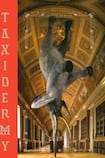
Taxidermy is Alexis Turner's beautifully designed homage to the long- established, curious and flamboyant art of skinning and stuffing dead creatures. Turner's examination of the practice encompasses religious beliefs, science and museums, interiors, fashion and advertising, tracking it all the way to the present day in a fascinating and occasionally queasy-making narrative. Some of the accompanying images will definitely challenge your stomach: stuffed freaks of nature such as an eight-legged piglet, a two-headed calf and a pair of conjoined lambs. Those are all examples of teratology in taxidermy; the study of abnormalities.
Anyone with access to the internet in 2013 can find images and videos of pretty much any living animal or bird. But in the Victorian era, the only lions and zebras and hummingbirds you were likely to see close up were stuffed. The educational aspect of the public being able to see exotic animals, albeit dead ones, led to the establishment of several well-known museums of natural history, among them our own Dead Zoo on Kildare Street in Dublin.
But there was no educational element attached to the other Victorian collections of exotic animals that filled the specially-made trophy rooms of wealthy hunters. The more big game you killed, the higher your social status became. Quantity was everything. Turner reports that one hunter in Kenya at the cusp of the 20th century killed 80 lions in a single day. In 1912, in what Turner describes as a "short" hunting trip to the Arctic, 21 polar bears were shot in 10 days. And by the time the famous Van Ingen taxidermy company of Mysore, India, closed, in 1999, it had mounted more than 43,000 tigers and leopards during the 90 years it was in business.
It wasn’t only members of the British Raj who loved to hunt big game. “In 1925, the Maharaja of Kotah had his Rolls Royce Phantom modified for tiger hunting by adding a machine gun and a cannon,” Turner writes.
Being practical, the Victorians found other uses for those parts of the beheaded animals they didn’t display in their trophy rooms. Taxidermy supported the fashion for such items as elephant-foot footstools, hippopotamus-tusk chandeliers, yak-foot doorstops, a leopard skull with the eye-sockets fitted with inkwells, and a hinged rhino’s head that opened to reveal a customised cocktail cabinet (all pictured, bar the rhino cocktail cabinet).
As for birds, they were sandwiched between the glass of firescreens, or displayed in domes in drawingrooms in the interiors fashion of the day. The more brightly-feathered the bird, such as hummingbirds or the long-tailed quetzals, the more desired they were by wealthy women, and the more of a talking point they were over afternoon tea.
The books of Beatrix Potter, with their talking mice, ducks, kittens, squirrels, frogs and rabbits contributed to the fashion for anthropomorphic taxidermy, and made famous the names of Walter Potter and Edward Hart. Their sentimental tableaux of kittens having tea parties, rabbits in a schoolroom, toads playing cards, and many other scenes of human activities, are still prized today at auction. Hart's best-known work is a series of five cases of boxing squirrels, still on display at the National Trust property of Castle Ward in Co Down.
After the horrendous loss of life in two World Wars, there was a gradual public revulsion towards hunting big game for sport. Hunting, collecting, and taxidermy all became unpopular. Many private collections were sold off or vanished from public view. Eton College, the famous boys' public school in England, auctioned off most of its collection as recently as 1996. The majority of it had been gifts from game-shooting deceased past pupils, and the auction attracted widespread media attention.
Advertising and art
After the millennium, taxidermy began to become fashionable again, although in very different forms than that of a century previously. Vintage items now turn up in pubs, restaurants and boutiques as ironic pieces of decoration. Judging from the photographs in this book, there's also a trend for customising taxidermy for private homes: half a vintage zebra leaps out of a hall wall; a white cat in a glass box has been turned into a bedside table; and a "contemporary" flamingo sits in the alcove of a bathroom.
Exotic animals legally being stuffed today can be only zoo deaths, roadkill casualities, or animals killed by each other. The trend for stuffing domestic pets, however, particularly dogs, continues to be popular, although as Turner notes, “It can be an emotional experience for the client, and some taxidermists prefer to decline these difficult commissions.”
In Victorian times, pets were either encased in glass, or had their heads mounted. The 21st-century naturalist fashion for displaying your dead stuffed pet is in a sleeping position, usually by or near the spot where they liked to sleep when alive, which is bound to surprise those guests who haven’t visited for some time.
The most public and visible examples of taxidermy now are in fashion, advertising and art. Couture designers, such as the late Alexander McQueen, made startling dresses and headpieces from feathers and pieces of birds. The artist Polly Morgan is making inventive and sought-after pieces in a new style of taxidermy; one work has stuffed chicks breaking out of lightbulbs.
Retailers and jewellers use taxidermy in dressing windows or in shoots: there is a picture in this book of an ostrich modelling seven necklaces, and a chihuahua festooned in diamonds. Inanimate models have the advantage of not moving under the camera lens, and an ostrich’s neck can display seven necklaces more efficiently than a human neck. Plus, you’re almost certain to look at it twice.
Taxidermy is a cabinet-of-curiosities of a book. It's beautiful, odd, intriguing, strange and sometimes repellent, just like the history of taxidermy itself.












